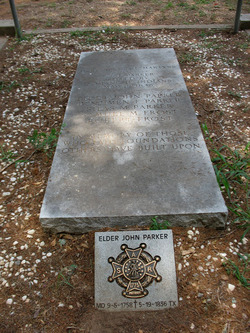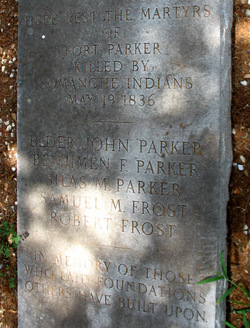John PARKER
SAR Patriot #:
P-265506
The following information was assembled from numerous sources and cannot be used directly as proof of Qualifying Service or Lineage.
It is considered a research aid and is intended to assist in locating sources that can be used as proof.
State of Service: VA
Qualifying Service: Private
DAR #: A087621
Birth: 06 Sep 1758 / Baltimore / MD
Death: 19 May 1836 Fort Parker / Milam / TX
Qualifying Service Description:
Captains Fields, Collier; Colonels Slaughter, Alexander
Additional References:
Pension: S32435
Spouse: Sarah/Sallie White
Children: Daniel; Susannah; Silas; Mary; Benjamin; Abigail; Phebe; Isaac; Nathaniel; Joseph; Daniel;
Members Who Share This Ancestor
| Date Approved | Society | ACN | SAR Member Info | Lineage via Child | View Application Detail | |
|---|---|---|---|---|---|---|
| 1966-01-18 | LA | Unassigned | James Porter Owen Jr (93137) | Daniel | ||
| 1968-03-14 | TX | Unassigned | Lee Parker Boone (96595) | Isaac | ||
| 1971-06-03 | TX | Unassigned | James Joseph Pridgeon (101420) | Daniel | ||
| 1977-02-07 | TX | Unassigned | Clinton R Hackney (112342) | Phoebe | ||
| 1977-02-07 | TX | Unassigned | Clinton R Hackney II (112343) | Phoebe | ||
| 1977-04-04 | TX | Unassigned | Clinton Rudolph Hackney III (112344) | Phoebe | ||
| 1992-12-02 | TX | 218953 | Robert Lewis Duckworth (134365) | Isaac | ||
| 1995-02-10 | MS | 210820 | Hubert Armstrong III (140632) | Mary | ||
| 1998-11-30 | AL | 2299 | John Riley Wallace (151053) | Daniel | ||
| 2002-01-24 | TX | 11790 | Jack Richard Pickle (157357) | Susannah | ||
| 2006-09-29 | TX | 26664 | Thomas Paul Wilkinson (167935) | Silas | ||
| 2009-12-22 | TX | 37369 | Andrew Michael Melton (173891) | Susannah | ||
| 2013-11-02 | MO | 55577 | Ronald Dean Pennington (189060) | Mary | ||
| 2014-09-04 | KS | 59959 | James David Riddell (164571) | Benjamin/Benjmen | ||
| 2017-07-28 | NM | 76063 | Alan Kenneth Farrington (203763) | Daniel | ||
| 2022-08-19 | TX | 103203 | Jeffrey Alan Owens (223544) | Daniel | ||
| 2022-12-16 | TX | 104750 | Toby Wayne Daniels (224709) | Mary | ||
| 2023-06-09 | TX | 107808 | Charles Lynn Parker Jr. (226949) | Silas | ||
| 2024-07-05 | TX | 112340 | Cash Jarrett Daniels (230422) | |||
| 2024-07-05 | TX | 112341 | Cooper Jackson Daniels (230423) | |||
| 2024-10-04 | TX | 113472 | Rodney Eugene Townsend (231272) |
Location:
Groesbeck / Limestone / TX / USA
Find A Grave Cemetery #:
Marker Type:
SAR Stake Marker
SAR Grave Dedication Date:
Comments:
- NSSAR stake marker
- Patriot contemporary stone, large stone covering the grave laying on the ground, legible
- Images 1 & 2, provided with permission from Julie Karen Hancock (Cooper) Jackson, Find-a-Grave member # 24420413
Directions to Cemetery / Gravesite:

